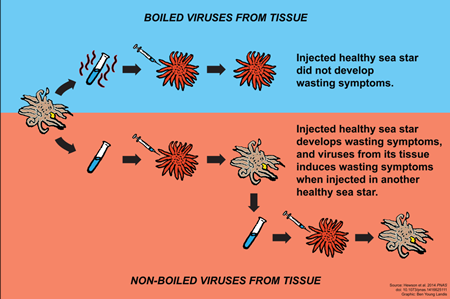By Rita Robinson | LB Indy

Millions of sea stars, virtually the entire west-coast population along the Pacific Ocean, disintegrated into slime from Alaska to Baja last year due to a densovirus, says a scientific report released last month. Even so, scientists are continuing to investigate human-made factors as an influence in the die off.
The disease was first spotted off the coasts of Washington and Alaska in June 2013 and then spread south, the report says. It hit the Laguna Beach coastline in spring. The “wasting syndrome” caused sea stars to become lethargic and their limbs to curl. They developed lesions on their rough skin much like leprosy and begin to seemingly deflate. Within hours, the sea stars “melt” in the water with arms and entrails floating away. They rarely recover, the report says.
The question that remains is why the massive die-off occurred with this particular virus, said Michael Murray, director of veterinary services at the Monterey Bay Aquarium and one of the report’s 25 authors. “What turned this thing on?” he said.
“What took the densovirus from a relatively innocent bystander and made it reproduce to the rates where it really caused a problem?” he continued. “Anthropogenic causes, pH changes in the ocean, chemical changes in the water, temperature changes, changes in the light, we’re going to be addressing those factors in a systematic fashion.”
“What we have is another indication of the harm that climate change is doing to our planet,” said Murray. “We’re not going to be able to save individual sea stars, but we can save the health of the ocean. This is part of the bigger discussion about our responsibility to climate change and ocean acidification.”
Sea star wasting disease was first noted in 1979, but last year’s massive wipeout may make the infection the largest known marine wildlife epidemic to date, says the report led by Ian Hewson, assistant microbiology professor at Cornell University in Ithaca, N.Y.
Healthy sea stars contracted the disease when scientists injected them with the densovirus microorganism taken from unhealthy ones, says the report, which describes the scientists’ inquiry. The virus was also found in plankton, sediments and other echinoderms, which scientists said indicates how the sea stars were exposed to the contagion. Scientists detected the virus in preserved sea stars as far back as 1942, which suggests that densovirus has existed in North American Pacific coastal waters for decades, they said.
Experiments by Hewson’s team found that the disease did not spread into marine aquariums that sterilize inflowing seawater with ultra-violet light. But it did spread into sand-filtered aquariums, which suggests a microscopic infection rather than a disease spread by contact, the report says.
Experiments also showed that when boiled, the viral solution lost its potency to infect healthy sea stars, which were injected with the boiled virus. The pattern suggests a water-borne, microscopic infectious agent rather than environmental or manmade pollutants as the cause of death, the report says.
Murray said scientists will continue to study sea stars in the lab by exposing them to changing variables that mimic environmental changes. “If we find there is a relationship between climate change and the chemical changes in the ocean and it results in sea star wasting, then we can find where the system is broken,” he said.
The ability of some organisms to build their exoskeletons and shells is affected by increased levels of CO2 absorbed in seawater from the atmosphere, according to the National Oceanic and Atmospheric Administration.
“We’ve got to do something to correct the impact we’re having on the health of the ocean and the health of the planet,” Murray said.
| The report on densovirus was published in the Proceedings of the National Academy of Sciences journal. It was originally slated for release in late summer but was delayed due to peer review requirements, Hewson’s office reported. |
The dying sea stars also released sperm and eggs into the ocean to spawn a new generation, noted a report from UC Santa Cruz’s Long Marine Lab earlier this year. The “reproduction bout” showed up in clusters of 200 or more baby sea stars at the Terrace Point tide pools below the lab in spring, said UCSC marine biology professor Pete Raimondi. Baby sea stars were expected to start popping up in tide pools in Southern California by now, said Raimondi, who heads the Pacific Rocky Intertidal Monitoring Program.
No significant populations have yet been sighted, although a few adult sea stars survived in the Orange County region, said Jayson Smith, assistant biology professor at Cal Poly Pomona. “I have also heard about the occasional high density of baby sea stars at a few specific locations but not on a scale to be excited or hopeful about,” he said.
Source: Proceedings of the National Academy of Sciences, October 2014
Here’s a related link: https://moboxmarine.com/blog/oceans-are-getting-acidic/




